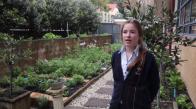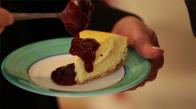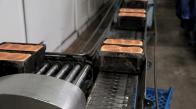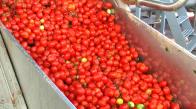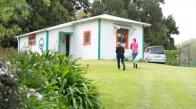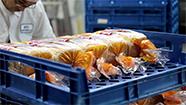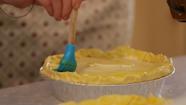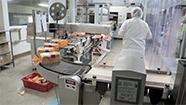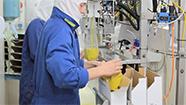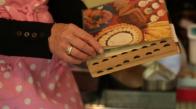Noeline Stewart and Hasting Girls' High School students share about developing products for community projects.
Manufacturing works well with community projects
Transcript
Noeline Stewart: So the community projects we do start off as developing a brief. So after we’ve worked on an issue and identified need and opportunity, then they work towards developing a product, and we find that leads really well into the manufacture of that product.
So they will have tested and trialled it and done functional modelling on it over a number of weeks. By the time they come to manufacture it in bulk, they are fairly competent with the outcome and how it should be and they’ve written some detailed specifications. Then they ramp up the quantities, so they’re doing double, or triple, or quadruple batches. And then from that we sell those products or give them, depending on the project that we’re doing that year. And that’s how we fulfill the manufacturing standard.
The girls work as a team with the person whose product it is that week actually being manufactured, being the leader for that team. And we like them to assign roles to specific team members if possible, so that they can be sure that the quality control is happening as it should. And they work with those students over the four spells in the week till they have manufactured the quantity that they need to. It takes a lot longer because they’re doing large batches. So sometimes part of the batch will be cooked on one day and then finished the next spell, as jams, things like that, that works for.
Student one: So last year, we were issued to design an appealing product for our stakeholders, which were Age Concern. This assignment had plenty of opportunities such as working with Age Concern, a really neat non-profit organisation, that plays a really big part of the community as it helps with the elderly.
Student two: I made a passionfruit and apricot jam. I did start off making a passionfruit and peach jam, but I found that peaches were quite a large cost and I was able to get the passionfruit and the apricots donated to me, which was really good for me. It kept my jam at quite a low cost, which was quite essential for the brief. At first, it’s quite hard directing a group because you’re not really sure what everyone’s going to say if you’re being a bit bossy, but along the way you kind of find out that you have to step forward, otherwise nothing's really going to happen. So if you don’t tell people what to do when you’re doing manufacturing, it’s not going to happen. And you just know that you have to do the same for them as well, so they’re going to end up being in charge of you.
So this year, I’ve been lucky enough to become a tutor for the year 10 students as well. So we get to use these directing roles that we used last year for the year 10s as well because we do need to help them learn the skills that we’ve learnt along the way. And I think it’s easier for us to help direct them in the right way rather than the teacher because they do seem to listen to us students, because we’ve been there before.
Student three: My product was a Christmas cake and I started trialling with a traditional Christmas cake using raisins and dates and sultanas. Just to make it, the project, more interesting for me, I chose to substitute the sultanas, raisins, and dates for dried wine grapes and dried apples.
Noeline Stewart: Manufacturing is a very busy practical and it requires a lot of organisation prior to the time. I have a very good technician who spends a lot of time sourcing ingredients and preparing things and making sure that everything the students need is there for them. Because of the type of products we do, we’ve used a lot glass jars and bottles and we’ve had to find a free source for those, so our local recycling centre have been fantastic, they save them for us and I go each Saturday morning and pick them up. I give them some baking and they give us the jars and bottles and then the girls wash them and clean them up and we recycle them.
There’s an awful lot organisation in terms of resources. So one of the things that’s been really important to help these projects actually succeed is being able to have donations of ingredients. And because the year 11 project is based on seasonal fruit and vegetables, and we do that in the first part of the year, we’re really lucky that there are often abundance of those things around and we’ve found the school community have been great in terms of making donations and there’s been several people within the community that have been involved, perhaps peripherally, where someone in their family perhaps got something from us and they’re kind of really keen to help. There was some people recently where I wanted to buy some rhubarb plants to help our production here at school and it turned out that her sister had got one of the Age Concern gift boxes, so she was very keen and she’s given us tomatoes and all sorts of bits and pieces. So when people donate us bulk foods like that we get them into the freezer and our freezer at this stage is virtually full, but we’ve been very lucky.
Related videos
Engaging community projects for food technology students (04:38)
Students make community connections through their technology projects.
Camberley School community project (03:54)
Noeline Stewart shares how her secondary students collaborated on a fundraising venture with a local primary school.
Melie's Cakes (02:46)
Amelia Ferrier is a year 12 student who has grown her love of baking into a successful business.
Food processing in a local environment – Hinterland Express Old Cottage Cakery (03:43)
Ann Davis makes pies and Christmas cakes in a cottage on the farm in Gisborne.
Food processing in a national environment – Walter Findlay Ltd (01:05)
Walter Findlay's makes bread that is distributed within Gisborne and up the east coast.
Food processing in a global environment – Cedenco Foods (03:28)
Cedenco foods in Gisborne makes ingredients that are sold on the domestic market and also sent to Asia.
Food safety in a local environment – Hinterland Express Old Cottage Cakery (02:59)
Ann Davis talks about the process she followed with the Gisborne District Council to acquire registration for her business....
Food safety in a national environment – Walter Findlay Ltd (03:13)
Matt Spencer explains that Walter Findlay Ltd bakery is thoroughly audited, to ensure compliance to their food safety programme....
Food safety and packaging in a global environment – Cedenco Foods (04:05)
Cedenco Foods is audited annually for their food safety accreditation. In addition they have two voluntary certifications that have global recognition....
Costing in a local environment – Hinterland Express Old Cottage Cakery (02:57)
Ingredients, equipment, and energy costs are considerations when calculating prices of pies.
Costing in a national environment – Walter Findlay Ltd (00:47)
Minimising waste by accurate processing controls costs at the Findlay's bakery.
Costing in a global environment – Cedenco foods (05:37)
Noel Amor the technical manager at Cedenco Foods talks about how they ensure an efficient operation and considerations when purchasing plant....
Food processing and testing in a local environment (03:03)
Ann uses family and friends to evaluate her pies. She uses pie cutters to achieve accurate pastry size for tins....



